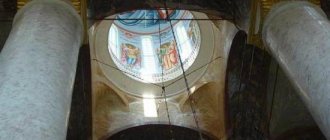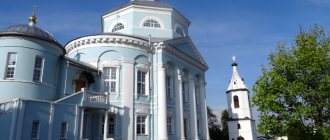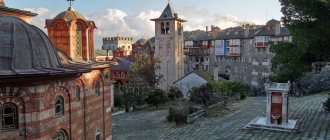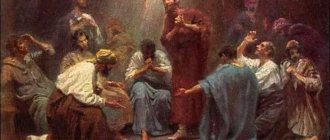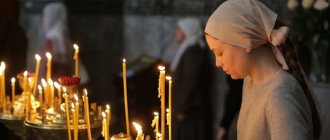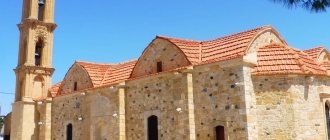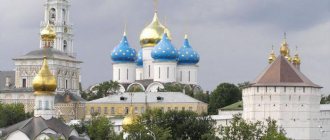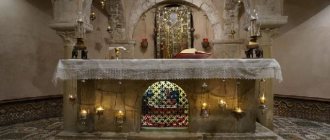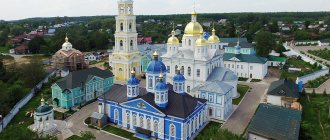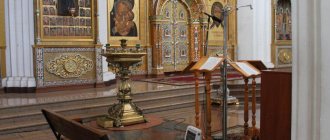"Save me, God!".
Thank you for visiting our website, before you start studying the information, please subscribe to our Orthodox community on Instagram, Lord, Save and Preserve † - https://www.instagram.com/spasi.gospodi/. The community has more than 60,000 subscribers. There are many of us like-minded people and we are growing quickly, we post prayers, sayings of saints, prayer requests, and timely post useful information about holidays and Orthodox events... Subscribe. Guardian Angel to you!
Christians usually call Palestine on both sides of the Jordan River the Holy Land. On its small territory, the most important religious and historical events took place, which are described in the Old and New Testaments. Every pilgrim considers it his duty to travel to Israel to the holy places.
Until 326, these places were not given special significance, and only St. Helena, the mother of Constantine the Great, laid the foundation for their veneration. Initially there were only four, but later the number increased. The Patriarchate of Jerusalem took full responsibility for the maintenance and preservation of sacred places, for the Christians of the Holy Land, as well as the responsibility for receiving pilgrims.
Since there was a long struggle for the Holy Places of Israel at certain times, the result was that some shrines went to some communities, while others were occupied by others. The same applies to their recognition: some are recognized by all Christians, while others are recognized only by those who practice them.
Jerusalem
A city that has experienced rise and fall, seen different cultures and civilizations and is a shrine to many thousands of people professing different religions - this is Jerusalem. Here the redemptive feat of Christ was accomplished. Any tour of the holy places of Israel begins from here, from one of the ancient cities, the cradle of three religions - Christianity, Judaism and Islam.
The walls of the city were built by the Turks in the 16th century, and the stones from which they are made remember the times of Herod and the Crusaders. On the site of the ancient city gates stands the Golden Gate, which attracts the attention of tourists.
According to Jewish beliefs, the Messiah was supposed to enter the city through these gates. Jesus made his entrance through them. Now the gates are walled up by Muslims so that the next Messiah cannot enter them. Many legends are associated with this gate. Tour guides always tell tourists and pilgrims an interesting fact that historical Jerusalem is located at a depth of 5 meters. That is, the streets of Jerusalem are in basements.
Sorrowful icon of the Mother of God
Walking away from the Kuvuklia along the gallery, you will come to the chapel “Dungeon of Christ”. The miraculous icon of the Sorrowful Mother of God is kept here. In 1986, tears flowed from the eyes of the Mother of God depicted in the icon. All believers interpreted this as a divine Easter miracle. Since then, the icon periodically streams myrrh, and many pilgrims visit the chapel in the hope of witnessing this miracle.
Free admission
Opening hours: daily, 4.30 – 20.00
Address: 1 Helena Str .
Stop: City Hall
Shrines of Jerusalem
The shrines of Judaism include the Temple Mount - Moriah, the holy place revered by the Jews - the Western Wall and the cave in Hebron. Muslim shrines include the al-Aqsa mosque, where the Prophet Muhammad was transferred to heaven before his ascension to heaven. For Muslims, this is the third most spiritually important city after Mecca and Medina. Christian shrines, first of all, are places associated with the birth and life of Jesus Christ. In Jerusalem, Christ preached sermons, in the Garden of Gethsemane he addressed the Father, here he was betrayed and crucified, pilgrims from all over the world come here to Via Doloroz. The trip is also interesting for tourists who love traveling to historical places. However, a trip to Israel to holy places is not always affordable during the Easter and Christmas period. Usually, during this period, the cost of plane tickets and services for pilgrims and tourists becomes higher.
Dome of the Rock
Not only representatives of Christianity and Orthodoxy, but also Muslims flock to Jerusalem to honor the third most important Islamic shrine - the Temple Mount and the Dome of the Rock mosque located here. At the heart of the Dome of the Rock is the stone from which, according to legend, the Prophet Muhammad ascended. The Dome of the Rock houses two important relics for all Muslims: the footprint of the Prophet Muhammad and his hair. Entrance to the Dome of the Rock is open only to Muslims.
Opening hours: Monday to Thursday, 7.30 – 10.30 and 12.30 – 1.30 (winter), 8.30 – 11.30 and 13.30 – 2.30 (summer)
Address: Temple Mount
Stop: City Hall
Temple Mount
In the Old Testament of the Bible, the Temple Mount is mentioned as the site on which the First Temple was built. It is here that, according to prophecy, the Last Judgment will take place on Judgment Day. An interesting fact is that this shrine is claimed equally by Jews, Christians and Muslims. What has happened in 2000 years on this top of Jerusalem! Jews and Christians who come to holy places in Israel consider themselves involved in the Temple Mount mentioned in the Bible.
The history of the events that took place over many hundreds of years has made its own amendments. Now the mountain is surrounded by high walls with a perimeter length of about 1.5 km, and in the square above the old city there are Muslim shrines - the Dome of the Rock and the al-Aqsa Mosque. Christians and Jews can be on the Temple Mount, but praying is strictly prohibited, as is bringing books and religious objects that are not related to the Muslim faith.
Tabha
In Hebrew, the name of the city sounds like Ein Sheva, in Latin - Heptapegon, in Arabic - at-Tabhiyya. If we translate all the names, each of them will mean “seven sources.” The name of the city confirms its unique location: there are 70 springs in the city area. Several important events took place on the site of the city, which are written about in the Gospel: the multiplication of loaves and fishes, the filling of fishing nets, the calming of the stormy sea.
Once upon a time, a Byzantine church stood on the site of the Church of the Multiplication of Loaves. According to legend, Jesus sat on the site of the church during one of his miracles. The modern church is built in the form of a basilica, decorated with magnificent mosaics. According to legend, under the main altar there is a stone on which Christ placed five loaves and two fish.
Wall of Tears
Those who come on excursions to the holy places of Israel will certainly come to the Western Wall, the miraculously surviving ancient wall of the Second Temple. There are rules on how to behave at the Western Wall. So, if you face the Wall, men pray on the left, women on the right. A man must wear a kippah. According to an unknown tradition, people place notes between the stones in the Wall with various requests to the Almighty. They are written mainly by tourists. When quite a lot of such notes are collected, they are collected and buried in a designated place near Maslenitsa Mountain.
For the people of Israel, the Wailing Wall is not only a symbol of grief for the destroyed temples. Somewhere in the subconscious of the Jews, this is rather a prayer carried through the centuries, a prayer of an exiled people for return from eternal exile and a request to the Lord God for peace and unity of the Israeli people.
Jaffa and Lydda
The city of Jaffa, according to legend, is the most ancient city in the world. Here on the seashore Noah built his ark, and his son Japheth became the founder of the city. The Apostle Peter lived in Jaffa for a long time: here, according to legend, he resurrected the righteous Tabitha. Pilgrims will be able to visit the Russian Church of St. Apostle Peter, Chapel of St. righteous Tabitha.
Lydda (Lod) is the birthplace of St. George the Victorious, and the Church of St. Great Martyr George the Victorious is also located here. In Lida there is kept a miraculous icon of the Mother of God that, according to legend, miraculously appeared during her lifetime.
We thank Yuri Akhmetovich Minulin, director of the Radonezh Pilgrimage Service, for his assistance in preparing the material.
Popular destinations for pilgrimage tours
All articles about pilgrimage tours on Subtleties
- Europe: Greece (Athos), Italy
- Russia: Diveevo, outskirts of St. Petersburg
- Israel
: Jerusalem - Jordan
- Middle East (Syria and Lebanon)
- Türkiye (according to the holy places of Byzantium)
How the site of Christ's crucifixion was found
The Romans, who destroyed Jerusalem, erected their pagan temples in the new city. And only in the time of St. Constantine, when the persecution of Christians stopped, in the 4th century, the question arose of finding the burial place of Jesus. Now they began to destroy the pagan temples and temples introduced by Hadrian in 135 - such is the story. The liberation of the shrine from the infidels took place through many military expeditions, called crusades. And after some time, Queen Helena found the place where the Savior was crucified. By order of the queen, the construction of a temple began on this site. In 335 the temple was consecrated. Historians talk about its beauty and grandeur. But less than 300 years passed before it suffered from the Persians. In 1009, it was completely destroyed by Muslims, and only in 1042 was it restored, but not in its former glory.
Safed
Safed or Safed is located in the north of the country, several tens of kilometers from Haifa. By Israeli standards, the city can be called highland; it is located at an altitude of 850 meters above sea level.
Safed is considered one of the four most important cities for Jews, over the centuries of its existence many significant events took place. During the Roman and Byzantine empires, Safed was a center of education; in the Middle Ages, the city turned into a large metropolis for those times, to which Jews expelled from Spain arrived. It was in this city that the first printing house in the Middle East was built; this happened in the 16th century. By that time, the city had become a center of Kabbalah for believers around the world.
The city can tell you a lot of secret and fascinating things; its ancient fortresses and synagogues on the shore have many secrets. And now the atmosphere of the city attracts creative people, sculptors, actors, writers, and in the artists' quarter, every city house is an original architectural work. Safed hosts exhibitions, shows, art galleries and theaters every year.
Church of the Ascension of Christ
The most important and most visited among the holy places of Christianity in Israel has always been the Church of the Ascension of Christ, or the Church of the Holy Sepulcher. Pilgrims arriving in Jerusalem first of all come to venerate the stone on which Jesus was anointed, in the Church of the Holy Sepulchre. The place where the temple was built and now operates was at the beginning of the first century outside the walls of Jerusalem, far from dwellings. There was a cave near the hill where Jesus was executed, and Jesus was buried in it. According to their customs, the Jews buried their dead in caves, in which there were several halls with niches for the deceased and an anointing stone on which the body was prepared for burial. He was anointed with oils and wrapped in a shroud. The entrance to the cave was covered with a stone.
The temple with many halls and passages, including the Holy Sepulcher and Calvary, is located at the end of the road along which Jesus walked to Calvary. Traditionally, on Good Friday, before Orthodox Easter, a procession of the Cross follows this path. The procession moves through the Old Town, along Via Dolorosa, which means “Way of Sorrow” in Latin, and ends at the Church of the Holy Sepulchre. Tourists who come to make a pilgrimage to holy places in Israel take part in this procession and worship.
Six Christian denominations, Armenian, Greek Orthodox, Catholic, Coptic, Ethiopian and Syrian, have the right to hold services in the temple. Each denomination has its own part of the complex and time allocated for prayers.
Relics of Grand Duchess Elizabeth and nun Varvara
Grand Duchess Elizabeth was a deeply religious person and devoted her entire life to religion and charity. After the death of her husband, Grand Duke Sergei Alexandrovich, she underwent the rite of communion and began to lead the life of an ascetic: she prayed a lot, observed all rituals and devoted all her time to helping the sick. In 1918 she was arrested and sent into exile. Nun Varvara, sister of the Martha and Mary Convent, where Princess Elizabeth spent her last years, went with her. The lives of both women ended tragically: in an abandoned mine, where they were pushed by merciless executioners. In 1920, the relics of the martyrs were brought to Jerusalem.
Today they are kept in the Church of St. Mary Magdalene.
Free admission
Opening hours: Tuesday, Thursday, Saturday, 10.00 – 12.00
Address: Gethsemane Convent
Stop: Mount of Olives
Garden of Gethsemane
A unique landmark of Jerusalem that you must see when visiting the holy places of Israel is the garden located at the foot of the Mount of Olives. According to the Gospel, Jesus Christ prayed here before the crucifixion. In this garden grow eight centuries-old olive trees, which are believed to have witnessed this prayer. Modern research methods have made it possible, based on radiocarbon analysis, to find out the real age of the olives growing in the garden.
It turned out that their age was very respectable - nine centuries. The researchers concluded that all these trees are related to each other, since they have one parent tree, next to which Jesus himself may have passed. History has preserved the fact that during the capture of Jerusalem by the Romans, all the trees in the garden were completely cut down. But olives have persistent vitality and could produce good shoots from strong roots. Which also gives us confidence that the current trees of the garden are the direct heirs of the very ones that Jesus saw.
Capernaum
This city, located near the “Sea of Galilee”, has a special role in history. In ancient times, Capernaum was a significant cultural center. In this city, Christ helped the mother-in-law of the Apostle Peter to be healed, raised Yair’s daughter from the dead, preached in the synagogue, and performed many different miracles. Thanks to all these significant biblical events, Christians began to call this place “His city.”
Above Capernaum rises the 125 meter high mountain of the “Sermon on the Mount”, it is also called the “Mountain of Beatitudes”.
Birthplace of the Virgin Mary
Visiting holy places in Israel includes a trip to the birthplace of the mother of Jesus Christ. Not far from the Sheep Gate, almost at the exit from the city, was the home of Mary’s parents, Joachim and Anna. Currently there is a Greek temple on this site. Above the entrance doors of the temple there is an inscription: “The Birth Place of Virgin Mary,” which translated means “Place of the Nativity of the Mother of God.” To get into the house, you need to go down to the basement, since the current Jerusalem, as the guide said, is about 5 meters higher than the previous one.
Jordan River
This is the river in which Jesus himself was baptized. It is interesting that even now Christians are baptized there. But those who have already been baptized can swim in the river wearing special white shirts and receive healing from illnesses.
Israel can rightfully be called the cradle of several religions. This place is unique because it allows you to see sacred and historical places with your own eyes. Once you find yourself in a sunny country, do not waste time and visit the named places. If you don't manage to visit them all on your vacation, come again. The atmosphere of the country is so unique and amazing that you want to “plunge” into it again and again.
Bethlehem and Nazareth
Pilgrims visiting Israel's Christian holy sites come to Bethlehem to visit the Church of the Nativity, built on the site where Jesus is believed to have been born.
The temple is more than 16 centuries old. Believers come to the temple to touch the star installed in the place where the manger stood; visit Joseph's cave and the cave with the burial of infants killed by order of Herod.
The next place of pilgrimage is the city where Jesus spent his childhood and youth. This is Nazareth. Here, in Nazareth, an Angel brought the Good News to the future mother of Christ, Mary. Pilgrims and tourists, visiting holy places, always go to it and 2 other churches: St. Joseph and Archangel Gabriel. Over the past decade, the Old Town of Nazareth has been renovated and the architectural beauty of its narrow streets has been restored.
Sites of the Way of the Cross in Jerusalem
The Savior’s Way of the Cross began with him. Praetorius is also considered a saint. Here, at the residence of the procurator, Jesus listened to the verdict pronounced on him, was crowned with thorns and received a cross, on which he was subsequently crucified. In particular, the three-door asp Ekke Homo has been preserved in the monastery of the Si Sisters.
As a starting point in the case of the Way of the Cross, it is of utmost importance. Indeed, thanks to numerous historical and theological studies, modern Christians have been able to accurately restore all the chronological and topographical milestones in the period relating to the Passion of Christ - from the arrest to the removal from the cross and the burial ceremony.
Initially, the Way of the Cross was defined from the Garden of Gethsemane, where Jesus was arrested. But in modern tradition it is considered to be from Pretorius. And during the procession, pilgrims make 14 stops along the way, each of which symbolizes one of the stages of the Passion of Christ.
Mount Zion and the Last Supper
An Orthodox Christian, like his brothers in Christ who profess other movements of this religion, knows what significance the Last Supper had for the emergence of the traditions of receiving communion among the first apologists of the church. It was the communion given by Jesus to his disciples that began the tradition of communion that all believers experience today.
Another significant event for this is the descent of the Spirit on the apostles. The Holy Scriptures also tell about this event in detail. But few know about the Last Supper and the descent of God the Father to earth. Meanwhile, this is precisely what is customary in Christianity to call the hill in the western part of the city.
Today the Chapel of the Last Supper and the Descent of the Holy Spirit is located in Jerusalem. This monument of Christian architecture is considered one of the oldest (it was erected in the second century after the Nativity of Christ). And despite the fact that in modern history, mostly Muslim prayer complexes are located on the territory of the Hill of Zion, the chapel remains free for visits and prayers.
Sacred Sites of the Mount of Olives
Mount of Olives or Mount of Olives - for all Christians without exception. On its slopes there are numerous churches and monasteries, uniting representatives of various Christian denominations in the service of the Lord. Thus, on the western slope there is the monastery of the Penitent Magdalene of the Russian Orthodox Church.
The northern slope is crowned by the Greek Church of the Galilean Pilgrims, erected at the site of the meeting of Jesus with his disciples after the resurrection. Here there is also a monastery with an Orthodox church in honor of John the Baptist. And on the territory given to representatives of Islam, the Ascension of the Lord is located - one of the main Christian shrines.
When planning to visit the Holy Land on a pilgrimage trip, you should not rely on random luck. By contacting the TOVIYA pilgrimage service to organize a tour, you will be able to choose a tour taking into account your financial capabilities and interests and will be pleasantly surprised by the high level of service and affordable prices for tours. Contact us and we will be happy to organize individual or group Christian trips for you at any convenient time.
To main
Other holy places in Israel
The usual program for tourists visiting the holy places of Israel is very eventful. You can stay in Jerusalem alone for weeks and discover something new every day. In order to somehow compress the deadlines and meet the allotted time for the tour, agencies organize free trips to the holy places of Israel included in the tour in buses, accompanied by a guide-interpreter. Of course, stops are made and there is an opportunity to take pictures for memory. From the bus window you can see the Mount of Beatitudes, where Jesus Christ delivered the famous Sermon on the Mount; drive through Cana of Galilee, where Christ turned water into wine. You can make a stop in the city of Jericho, which, according to experts, is more than 6 thousand years old.
Not far from the city is the Mountain of Temptations and the Forty Days Monastery, where Jesus fasted for 40 days after his baptism. The next stop is at the Jordan River, at the site of the baptism of Jesus by John the Baptist. And the sign that swimming here is prohibited does not stop a group of tourists.
The time allotted for a tourist trip passes quickly. Impressions, photographs and some souvenirs will long remind you of the days spent in holy places. And, of course, recommendations to your friends and family: “Be sure to go to Israel.” There are many places that I would like to see in the Promised Land, which is why pilgrims and tourists constantly come here to once again touch the holy places.
Pilgrimage to the Holy Land
| Jerusalem |
Undoubtedly, the spiritual center, as if the heart of the Holy Land, is Jerusalem. It is here that the main shrines of the entire Christian world are located. Here the redemptive feat of Christ the Savior took place. Many prophecies and promises are associated with this city - both Old and New Testaments. And in the book of Revelation, in the Apocalypse, we read about the Heavenly, new Jerusalem - the city of God: “And I John saw the holy city, the new Jerusalem coming down from God from Heaven, prepared like a bride adorned for her husband.”
But first,
a little history
. Once upon a time in these places there was a small village called Jebus. It was located at the foot of Mount Moriah - the same mountain on which the forefather Abraham was supposed to sacrifice his only son Isaac to God. Then the Lord, having tested the faith and love of the righteous man, did not allow this sacrifice to take place. Centuries will pass, and very close to this very place the Son of God will offer himself as a Sacrifice for the sins of the world.
It was here in the 10th century BC. King and prophet David moved the capital of the Kingdom of Israel, which until that time was located in Hebron. Ancient Jerusalem was built on a hillside south of Mount Moriah. Under the son of the prophet David, King Solomon, Jerusalem was expanded, and the first Jerusalem Temple was built on Mount Moriah. Now this place is called the Temple Mount. The temple, built under King Solomon (in 950 BC), is called the First Temple
.
It was destroyed by the Babylonians in 576 BC, when the Jewish people were taken captive by King Nebuchadnezzar. The famous Babylonian captivity lasted 70 years. Returning to their homeland, the Jews built a new temple on the site of the destroyed one. The construction was led by the prophets Zerubbabel and Ezra. And from 515 BC. The so-called Second Temple
. Nehemiah in the 5th century BC. restored the gates and walls of Jerusalem. Then Judea became part of the empire of Alexander the Great (the so-called Hellenistic period); in the 2nd century, Antiochus Epiphanes tried to turn the Temple of Jerusalem into the temple of Zeus, but this was prevented by the Maccabean uprising. In 63 BC. Judea was captured by the Romans and became part of the Roman Empire.
During the times of the Gospel, King Herod the Great ruled in Judea. This was the first king of the Jews who came from foreigners. He was installed by the Romans, and achieved power through cunning, deceit and bribery. Let us remember the prophecy of Patriarch Jacob that the Messiah will come when a non-Jew ascends the royal throne in Judea. While outwardly adhering to Jewish customs, Herod remained a pagan at heart. He built theaters and amphitheaters in cities and even in the suburbs of Jerusalem, and organized pagan shows and games. Distinguished by his cruel and ferocious disposition, being extremely ambitious and suspicious, he was very afraid of losing power and put to death anyone who seemed dangerous to him. To win the favor of the Jews, King Herod reconstructed the Temple of Jerusalem, seeking to give it greater splendor. Herod also built the fortress of Antonia, which became the center of the Roman presence in Jerusalem. There was the residence of the Roman procurator (or, in Greek, “hegemon”), and the Roman military garrison was located there. Herod the Great died a year after the birth of the Savior into the world.
The Gospel also mentions Herod Antipas, one of the sons of Herod the Great, ruler of Galilee and Perea. He was brought up in Rome, and with his rule he tried in every possible way to please the Roman emperors: Augustus, and then Tiberius, in whose honor he named his new capital, which he built on the shores of Lake Galilee. This Herod beheaded Saint John the Baptist. Pilate, who was in the bonds of Christ, sent Antipas to Herod, trying to get away from a difficult situation for himself and shift responsibility to Herod.
Jerusalem was razed to the ground in 70 AD, literally “not one stone was left upon another,” according to the word of the Lord. Thus the Romans suppressed the Jewish revolt against their rule. All that remains of the Second Temple is the western wall of the outer enclosure built by Herod (or the Western Wall, as it became known in the 16th century, when Jews began to gather here to pray). The Christian community of Jerusalem then fled to the city of Pella, located beyond the Jordan.
Later, under the Roman Emperor Hadrian, a new city was built on the site of Jerusalem, which was named Aelia Capitolina. It had a structure similar to a Roman military camp and was clearly divided into four squares. At the same time, the city boundaries were changed, and Golgotha found itself inside the new city walls.
When the Roman Empire was divided into Western and Eastern, Jerusalem came under the rule of the Byzantine emperors. However, in 614 it was conquered by the Persian king Khozroes and Muslims became the masters here. Many martyrs, venerable martyrs, suffered at their hands: the Persian conquerors desecrated shrines, broke into monasteries, killing all the monks. During the Crusades, Jerusalem belonged alternately to European knights and Muslims. And from 1517 to 1917, the Holy Land was under the rule of the Ottoman Empire. In World War I, Türkiye was forced to cede Palestine to the British.
In 1948, the State of Israel was established. However, Jerusalem finally went to Israel only in 1967 after the “six-day war”.
Let's take a look at the city panorama
.
In 691, the famous Dome of the Rock mosque was built on the site of the Jerusalem Temple. This huge golden dome stands out brightly in the skyline of Jerusalem. It covers the rock on which the patriarch Abraham was supposed to sacrifice his son Isaac. This place is very revered by Muslims, since, according to their beliefs, from this place the Prophet Muhammad ascended to heaven.
The walls of the old city that we see now were built by the Turks in the 16th century, however, the stones from which they are made are much older. There are stones from the time of King Herod, stones with Lanin inscriptions, stones with signs of the Crusaders. Jerusalem is located on mountains, of which the most famous are the Temple Mount, Mount Zion and Mount Olivet.
| Jerusalem. Golden Gate |
The Golden Gate also attracts attention.
They stand on the site of the oldest gates of the city (they were previously open). This was the only gate that led directly to the Temple Mount. It was through these gates that the Lord passed through, making His entry into Jerusalem before His suffering. According to Jewish beliefs, the Messiah was supposed to come from the east and enter the city through the Golden Gate. Which, in fact, came true. But the Jews are still waiting for the Messiah, and the Muslims have walled up the gates to block his path. And they even specially built a Muslim cemetery in front of them, so that the Jews would disdain to pass through it. There are many legends associated with this gate. There is a legend that these gates will open only before the Savior during the Second Coming, but they will not open before the Antichrist. The border of the city from the east was the Kidron Valley (separating the Temple Mount from the Mount of Olives), along which flowed the Kidron Stream, now dry, and the Jehoshaphat Valley, an ancient Jewish cemetery. According to legend, the Last Judgment will take place at this place. The western border of the city passed in front of the current Church of the Resurrection of Christ. The gray domes of this temple are also visible in the panorama. They are located further behind the golden dome of the mosque. At the time of Christ, this place was already outside the city walls.
And another necessary note: historical Jerusalem went underground by about 5 m, i.e. the former streets are now in basements.
Church of the Resurrection of Christ (Church of the Holy Sepulcher)
| Jerusalem. Holy Sepulcher |
The first thing every pilgrim who arrives in the Holy Land strives to do is to venerate the main shrine of the Christian world - to fall before the Holy Sepulcher.
Following the myrrh-bearing women, who were drawn to the Tomb of Christ by their great love for the Teacher, Christians now come to this Life-Giving Tomb, drawn by the same love for their Savior and Lord. They see the empty Tomb, in which the body of Christ rested for three days, and become witnesses to the Resurrection. How can one not remember at this moment the Easter stichera: “The myrrh-bearing women, deep in the depths, presented themselves to the Tomb of the Life-Giver, found an Angel, sat on a stone, and having spoken to them, said this: that you seek the living with the dead; that you are crying for the imperishable aphids; Go and preach to His disciples.”
At the time of Christ, this place was located outside the city. After the destruction of Jerusalem by the Romans, pagan temples were built here. And only in the 4th century, during the reign of the holy Emperor Constantine, when the persecution of Christians ceased, the holy Equal-to-the-Apostles Queen Helen, having destroyed the temples of idolaters, found the Holy Sepulcher, the place of the crucifixion of the Savior, and found the tree of the Life-giving Cross. Then, at her command, the construction of a temple in honor of the Resurrection of Christ began on this holy place. Construction lasted ten years, from 326 to 335. Church historians talk about the extraordinary beauty and majesty of the temple. On September 13, 335, it was solemnly consecrated.
In 614, the temple suffered greatly from the Persians; soon they tried to restore it, but in 1009 it was again completely destroyed by Muslims. In 1042, with the support of the Byzantine emperor Constantine Monomakh, the temple was again restored, however, no longer in its former splendor. In 1130 it was rebuilt and significantly expanded by the Crusaders. They united all the sacred places under one roof: the Holy Sepulcher, Golgotha. Since then, the temple has repeatedly suffered from fires and earthquakes. Most of the temple now belongs to the Jerusalem Orthodox Church; separate chapels belong to the Armenian, Coptic, Catholic, Syro-Jacobite and Ethiopian Churches.
When we enter the Church of the Holy Sepulcher, right in front of us is the Stone of Anointing. This is the stone on which the Savior’s body was laid after being removed from the Cross in preparation for burial. Remembering this, the stone is constantly watered and rubbed with incense.
| Jerusalem. Holy Sepulcher |
According to Jewish customs, the dead were buried in caves, inside of which there were two rooms. The first is more spacious, in which they mourned the deceased and psalms and prayers were read over the body of the deceased. And the second room was the burial room, where the body of the deceased was placed on a stone bed carved into the rock. The family crypt could have several burial niches. At the entrance to the cave, a stone (one or two) was installed, on which the body of the deceased was prepared for burial - washed, anointed with aromas, oils and clothed in a shroud. These were the stones of anointing, similar to what we see in the Church of the Holy Sepulcher. The entrance to the burial cave was blocked with a huge stone. There was also a custom after about a year to open the cave and wash the bones of the buried person in incense and put them in a special box for subsequent reburial. As a rule, this box was placed in a special niche in the same cave. If a family or entire clan changed their place of residence, they could easily take with them the bones of their deceased relatives. And someone else could have been buried in the cave after that. Therefore, the Gospel says about the Holy Sepulcher that it was “a new tomb, in which no one had yet been laid”
(John 19:21).
But let's return to the Church of the Resurrection. To the left of the Stone of Anointing is the passage to the Holy Sepulcher. To the right is Golgotha. Near Golgotha there was a square where people gathered to watch the execution of criminals. On the western side there were gardens and the garden mentioned in the Gospel, belonging to Joseph of Arimathea, in which the tomb that became the Holy Sepulcher was located. Near the rock there was a hollow where the bodies and crosses of those crucified were thrown. It was in it that Queen Helen subsequently found the Life-Giving Cross of the Lord.
Calvary
| Calvary |
Golgotha is a small rocky hill whose name comes from the Hebrew “Gulgolet” - “forehead, skull”.
This rock was called so because of the similarity of its rounded shape to a skull. An ancient legend claims that Adam's head was buried on this mountain. A staircase now leads to the top of Golgotha, located to the right of the entrance to the temple and from the Stone of Anointing. Climbing along it, we see a large Cross installed behind the main altar. This is an Orthodox altar. To his right is the Catholic chapel. Under the Orthodox throne there is a hole framed with silver. It marks the place where the Cross of the Savior stood. Pilgrims kneel, put their hand into the hole and touch this holy place, washed by the Blood of Christ. Here the Redemption of the human race was accomplished. To the left and right of the altar, under the glass, you can see the original rock of Golgotha Hill. The crosses of the robbers, standing somewhat behind the Cross of Christ the Savior, are indicated by black circles on the marble platform of Calvary. You can go down using another staircase. Under Golgotha there is a chapel of Adam, who, according to legend, was buried here. And the Blood of Christ - the new Adam - washed the bones of the forefather. The throne here is consecrated in honor of St. John the Baptist. Behind the glass you can see a rock with a crevice formed in it. The split in the rock occurred at the hour of the Savior's death on the Cross. It can be seen that the rock is split against biological layers. “Jesus cried out with a great voice and gave up the ghost. And behold, the curtain of the church was torn in two from the highest to the lowest: and the earth shook, and the stone was disintegrated...”
(Matt. 27:50-51).
From this chapel you can go to the treasury (it is not always open). There is the world's largest particle of the Life-giving Cross of the Lord and many relics of saints.
Let's return to the Stone of Anointing and move on. We see a small Armenian chapel, which is a round slab of white marble surrounded by columns - this is the place where, according to legend, the Mother of God stood during the execution of Her Son and Lord on the Cross.
Holy Sepulcher
| Edicule |
The Chapel of the Holy Sepulcher is called Kuvuklia
(translated from Greek as “chapel with a funeral bed”). It is inside it that there is a cave in which the Savior was buried. When the body of Jesus Christ was removed from the Cross, He was buried in a nearby burial cave that belonged to Joseph of Arimathea, a secret follower of Christ. Moreover, the tomb was new; no one had been buried in it before. According to Jewish custom, the body of Christ was anointed with incense and entwined with a wide quadrangular cloth - the shroud. The entrance to the cave where the Savior was buried was blocked with a huge stone. The anger of the Sanhedrin also guessed that they would place a guard at the tomb, since the Jewish leaders were afraid that the disciples would secretly take away the Teacher’s body and say that He had risen.
The Edicule preserves the usual structure of an ancient tomb, which, as we have already said, consisted of two rooms. A pilgrim entering inside first finds himself in the first chapel, now called the Angel's chapel.
. In the center of this small room we see a low column - the stone on which the Angel sat, who announced the Resurrection to the Myrrh-Bearers. When the Liturgy is served in the Edicule, this stone becomes a throne, and the Holy Sepulcher itself becomes an altar. From the Angel's chapel a very low passage leads to the burial room where the Holy Sepulcher is located. It is customary to leave it in such a way as not to turn your back to the Tomb.
“Come from the vision of the woman who brought good news, and cry to Zion: receive; from us the joy of the annunciation of the Resurrection of Christ: rejoice, rejoice and rejoice, O Jerusalem, seeing the King Christ from the Tomb as the Bridegroom comes.”
(Easter verses).
Behind the Edicule there is a small Coptic chapel, notable for the fact that in it, by kneeling, you can touch the original stone of the burial cave. After all, now this cave is covered with marble, surrounded by columns...
| Jerusalem. Funeral rite on Good Friday. The Shroud, sprinkled with rose petals, is wrapped around the Edicule. |
During Holy Week on Good Friday, a service is held on Calvary, the Holy Shroud is taken from Calvary, placed on the Stone of Anointing and there it is sprinkled with rose petals - just as the body of the Savior was anointed with aromas and incense.
After this, the Shroud is wrapped around the Edicule, rests on the Sepulcher, and the Edicule is sealed (as the Jews sealed the Savior’s Tomb). This is how the Gospel events come to life here. Become reality. “Let all human flesh be silent and let it stand with fear and trembling...” the Church sings on Holy Saturday. We must not forget these sacred lines of Orthodox worship, especially here, in the most holy place in the Universe, where our Salvation was accomplished. On Holy Saturday, the miracle of the descent of the Holy Fire takes place at the Holy Sepulcher. Mentions of this miracle are found very early, from the first centuries of Christianity. Many have tried and are trying to refute this miracle, but so far no one has succeeded. The first witness of the miraculous light in the Holy Sepulcher was the Apostle Peter. As it is sung in the 8th tone at Sunday Matins: “...and speedy Peter appeared at the Sepulchre, and the light was in vain in the Sepulchre, terrified.”
| Column in front of the temple entrance from which the Holy Fire came out |
And for two thousand years now the Holy Fire has been descending on the Holy Sepulcher.
On Holy Saturday, all candles in the temple are extinguished and no fire remains. In the middle of the bed of the Life-Giving Tomb, a lamp filled with oil is placed, and 33 candles are placed nearby - according to the number of years of the earthly life of Jesus Christ. The Orthodox Patriarch enters the Edicule for prayer. Before this, he is thoroughly searched to exclude forgery. The Armenian bishop is allowed to enter the chapel of the Angel. There is no specific time when the Fire descends. Sometimes 5 minutes pass in prayer, sometimes 10, sometimes 20... there were cases where they waited an hour or two. Before the descent of Fire, a bluish glow and flashes vaguely reminiscent of lightning are visible in the temple. Moreover, these outbreaks occur both high under the dome and below, and they do not correspond to any earthly natural phenomenon. Sometimes the lamps light up by themselves. When the Holy Fire descends, it spreads through the temple with lightning speed from the Patriarch’s candles. And from the many candles and lamps the temple literally turns into a sea of fire. Moreover, the Holy Fire does not burn at first and it is whiter in color, not the same as ordinary earthly fire. Sometimes miraculous healings occur from it. It is impossible to convey in words what a person who witnesses this Miracle experiences, and it is not necessary - it is too reverent and intimate. Once upon a time, the Armenian clergy ensured that the Orthodox were not allowed to visit the Tomb on Holy Saturday. The Armenians waited in vain for the Holy Fire in Edicule. The Orthodox Patriarch and his flock prayed on the street. Then Fire came out of the column at the entrance to the temple (on the left), forming a crack that is still visible today.
Opposite the Edicule is the Catholicon
- the largest, main, Orthodox chapel.
Let us now walk through the Church of the Resurrection, which has many more remarkable shrines under its roof. If we stand facing Kuvkulia and go to the right, then the first thing we will encounter is a Catholic chapel dedicated to the Holy Equal-to-the-Apostles Mary Magdalene. According to legend, here she met the Risen Lord. Let's walk further through the gallery. At the northern wall in the corner we will see a small chapel called “Christ’s Prison”
. The chapel was consecrated in honor of the Dormition of the Mother of God. Here in Gospel times there was a small cave in which convicts were kept awaiting execution. In this chapel there was a miraculous image of the Blessed Virgin Mary, called the “Mother of God of Sorrows”. But the icon was severely damaged by the carelessness of pilgrims and, after restoration, was placed in the church office. In front of the chapel there is an altar, under which there are stone blocks, similar to those that can be seen in the praetorium dungeon.
| Place of finding the Life-giving Cross of the Lord |
We walk further through the gallery. The next small chapel is dedicated to the holy martyr Longinus the centurion
.
Saint Longinus was one of the Roman soldiers who stood guard at the Cross of the Lord. The Gospel tells us about him: “The centurion and those with him who were guarding Jesus, seeing the earthquake and everything that happened, were greatly afraid and said: Truly this was the Son of God”
(Matthew 27:54). Saint Longinus subsequently became a Christian and suffered martyrdom. The chapel belongs to the Orthodox Church.
The next chapel, which belongs to the Armenian Church, is dedicated to the Division of the Savior's Robes
.
This is what the Gospel of John tells us about this: “When the soldiers crucified Jesus, they took His clothes and divided them into four parts, a piece for each soldier, and a tunic;
The tunic was not sewn, but entirely woven on top. So they said to each other: Let us not tear it apart, but let us cast lots for it, whose it will be, so that what is said in the Scripture may be fulfilled: They divided My garments among themselves, and cast lots for My clothing. This is what the warriors did." (John 19:23-24).
The next chapel, closest to Golgotha, is the Orthodox chapel of the Crown of Thorns
. Under the throne there is part of a column moved here from the praetorium. According to legend, the Savior was tied to this pillar during the scourging. Another legend says that they planted the Savior on this pillar, putting a crown of thorns on him, and mocked Him.
| Icon before which the Venerable Mary of Egypt found repentance |
Between the chapels of the Dividing of the Robes and the Crown of Thorns there is a staircase along which we can go down to the place where the Holy Queen Helen found the Cross.
First we will find ourselves in the Armenian chapel dedicated to Equal-to-the-Apostles Helen. Let's go through it and go down even lower into the cave of the Finding of the Life-Giving Cross. The place where the cross was found is located on the right, it is marked by a slab with the image of a cross. On the left is the Catholic throne with a statue of Saint Queen Helen. Behind the Edicule, behind a row of columns, there is a Syro-Jacobite chapel, in the wall of which is the entrance to the ancient burial caves. There is a legend that the righteous Joseph of Arimathea and Nicodemus were buried here.
To the left of the entrance to the Church of the Holy Sepulcher (if you stand facing the entrance) there are three temples: the Myrrh-Bearing Women, the Forty Martyrs of Sebaste and James the Brother of the Lord. In the Church of the Apostle James there is a miraculous icon of the Mother of God, before which the Venerable Mary found repentance. Here she, not allowed by the invisible power of God to enter the Church of the Resurrection of Christ, raised her gaze to this image of the Most Holy Theotokos, the grace of God illuminated the sinner’s conscience and she suddenly saw the depth and abomination of her iniquities. From this icon the saint received a blessing for her feat.
On Thursday of the 5th week and in the fifth week of Great Lent, the Holy Church remembers and glorifies the exploits of the Venerable Mary of Egypt, remembering the unprecedented feat of her repentance.
And to the right of the entrance to the Church of the Holy Sepulcher (if you stand facing the entrance) you can go through the Coptic temple to the roof to the dome of Golgotha. And after passing through another temple belonging to the Copts, you can see a very ancient water tank. This water was used for the needs of the Temple of the Resurrection, built by Queen Helen, Equal to the Apostles.
Place of the Nativity of the Mother of God
Not far from the gates of the old city, closest to Gethsemane, was the house of the righteous Joachim and Anna.
These gates have several names: their ancient name is Sheep Gate, since next to it there was a Sheep Pool (Bethesda); Lion - in the Arab tradition, due to the lions depicted on the gates - the heraldic emblem of Sultan Baibars; Stephen's is a Christian name, since nearby, near Kidron, the first martyr Archdeacon Stephen was stoned. On the site of the house of Saints Joachim and Anna there is now a Greek temple. Above the door is written in English: “The Birth Place of Virgin Mary” (“Place of the Nativity of the Mother of God”). You have to go down into the preserved premises of the house where the Blessed Virgin Mary was born, because Jerusalem is now higher than in those days.
Bethesda
| Pool of Bethesda |
Immediately behind the house of the righteous Joachim and Anna is the ancient Sheep Pool, called Bethesda (Beit Hisda), which translated from Hebrew means “house of mercy.”
Here the famous miracle of the Savior’s healing of the paralytic, who had suffered from his illness for 38 years, took place, as recounted in the Gospel of John. This font was called a sheep's font because sacrificial lambs were washed in it. This entire complex belonged to the Jerusalem Temple, the buildings of which were located very close by, and the water was intended for temple needs. From time to time an angel came to the pool and disturbed the water in it. And whoever first entered the font after this disturbance of the water recovered from his ailments (John 5:1-9). The font consisted of two pools 11 m deep, separated by an isthmus. Around the pools there were five covered galleries (as described in the Gospel: “five porches”).
Now we see here excavations of an ancient font and later structures. The deep cistern on the left side is very ancient, apparently related to the font itself. Empress Helena built a Christian temple here - its remains can now be seen in the center of the excavation complex. Later, the pagan rulers built here the temple of Asclepius, who was revered by them as the god of healing. The Romans built their catchment cisterns here, one of which still holds water today.
This entire complex now belongs to Catholics and access to it is only possible for a fee. Near the excavations of Bethesda there is a Catholic church (12th century), dedicated to the righteous Anna.
Russian Spiritual Mission
The Russian Spiritual Mission in Jerusalem was founded in 1847.
It then consisted of Archimandrite Porfiry (Uspensky), who headed it, Hieromonk Theophan (the future saint and recluse Vyshensky) and two more people. Initially, the Russian Spiritual Mission did not have its own premises. But in 1858, after a pilgrimage to the Holy Land of Grand Duke Konstantin Nikolaevich and his wife, the issue of acquiring a plot of land in Jerusalem for the Russian Spiritual Mission was resolved. This site is located on Jaffa Street, outside the walls of the old city. In 1872, a large Trinity Cathedral was built here, where regular services are held to this day. Around the cathedral there were administrative buildings of the Mission with a house church in honor of the martyr Queen Alexandra and a hotel for pilgrims. The Mission's tasks included caring for numerous Russian pilgrims: their spiritual support, as well as providing housing, food, and medical care. Unfortunately, in 1964, Nikita Khrushchev sold almost the entire plot that belonged to the Russian Mission to the State of Israel. Only the cathedral and part of one of the buildings remained in the ownership of the Mission.
In the Trinity Cathedral there is a miraculous image of St. Nicholas the Wonderworker, who once saved Russian pilgrims from death in a shipwreck. This icon is placed on the right choir, in the second row.
Other holy places in Jerusalem
| Prison of the Apostle Peter |
In the old city there are many more small monasteries, many attractions and shrines. Let's talk about some of them.
Prison of the Apostle Peter, Monastery of St. Nicodemus
Among the narrow streets and quarters of the old city near Pretoria there is a small Greek monastery dedicated to the holy righteous Nicodemus. In the crypt of the monastery temple there is a dungeon in which the Apostle Peter was imprisoned and from where he was miraculously taken out by an Angel (Acts 12: 1-10). The original chains with which the Apostle Peter was chained are now kept in Rome. And here is currently a copy of them. Among the other shrines of the monastery is the miraculous Shroud of the Savior, woven by Russian monks.
| Cave of St. Melania the Roman |
Monastery of Great Panagia. Cave of St. Melania the Roman
Not far from the Church of the Holy Sepulcher there is a monastery called the Great Panagia, named after the miraculous image of the Blessed Virgin Mary, which resides here.
This icon was found unharmed after one of the fires in the Church of the Resurrection. This monastery is one of the oldest in Jerusalem. Tradition tells that from this place, located near Golgotha, the Most Holy Theotokos saw Her Divine Son crucified on the Cross.
In the temple of the monastery there are many relics of various saints, including the holy Apostle James, the holy martyrs Kirik and Iulita. Under the temple there is a cave in which the Monk Melania labored. It was here that her holy relics rested hidden, later taken by the crusaders to Venice.
Monastery of Malaya Panagia (Sretensky or Saidanaya)
| An icon depicting the grandmother of the Blessed Virgin Mary - Holy Righteous Mary |
Another small monastery, lost in the quarters of the old city on the border between the Christian and Muslim quarters, is dedicated to the Blessed Virgin Mary, her miraculous image of the Small Panagia.
The temple of the monastery is consecrated in honor of the righteous Simeon the God-Receiver and Anna the Prophetess, and has a chapel in honor of All Saints. From the outside, nothing tells us that a holy monastery is located here. Actually, this is a small temple among rather squalid residential buildings. But the monastery is very remarkable. Here you will be very warmly greeted by a Greek nun who carries out obedience in this holy place. In the temple of the monastery there is a miraculous icon of the Mother of God, called the Small Panagia or Saidanaya (First Lady). According to legend, this icon itself came to Jerusalem from the Damascus convent of Saydanaya and, taken back there, miraculously appeared again in Jerusalem, where it remains to this day. One day the miraculous image was stolen from the church, but just as miraculously returned. The kidnapper fell into relaxation and, having repented, received healing. In gratitude, he decorated the icon with a silver chasuble. This icon is very small and now the niche in which it is located is closed with bars.
Also venerated here is a very rare icon, which depicts the grandmother of the Blessed Virgin Mary - the holy righteous Mary, who was distinguished by a very pious life. According to legend, here was the house of the parents of Saint Righteous Anna - the mother of the Blessed Virgin Mary.
